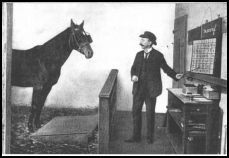 In 1891 William von Osten, a German, started displaying his horse "Clever Hans" before the public. His claim was that Hans could answer questions by tapping his hoof: numbers were simply counted, the alphabet was encoded as "A"=one tap; "B"=two taps etc.
In 1891 William von Osten, a German, started displaying his horse "Clever Hans" before the public. His claim was that Hans could answer questions by tapping his hoof: numbers were simply counted, the alphabet was encoded as "A"=one tap; "B"=two taps etc.
Von Osten believed that animals possess an intelligence that is equal to that of a human. In his quest to prove this he attempted to teach animals, including a cat and a bear, how to do simple calculations; however, it was only Hans who showed any ability.
Hans's intellectual abilities included performing mathematical calculations, telling the time, identifying musical intervals, and naming people. Before long, Hans was doing more complex calculations such as square roots. Hans was not always correct, but was correct so often that his ability required investigation.
Testing Hans
Hans had been tested by many people, one even claiming that Hans had the intellectual ability of a fourteen year old boy, but the first scientific testing was done in 1904 by Professor Carl Stumpf.
Stumpf was looking for evidence of cheating or trickery to explain Hans's ability: he found none. Subsequently, Stumpf endorsed Hans's ability as genuine. With this scientific endorsement, Hans became a sensation and people flocked to see his demonstrations.
Other scientists, however, remained sceptical.
In 1907, Oskar Pfungst, in collaboration with Stumpf, re-tested Hans in a classic case of psychology. A group of thirteen scientists was assembled, known as the "Hans Commission".
Hans did have an ability of some kind; the psychologists designed experiments to find out what this ability was. No evidence of cheating was found, although they did find an answer to the phenomenon.
Hans was tested inside a large tent to avoid outside distractions such as spectators. The tests were designed so that:
- A large number of questions were used to eliminate the effects of chance;
- Different questioners were used in case Hans was picking up signals from von Osten;
- The questioners sometimes knew the answers to the questions they were asking, other times they did not;
- The questioners would stand at different distances from Hans during different trials;
- Some trials would be run with Hans blinkered.
The test results
The first thing that became apparent was that Hans needed visual contact with the questioner in order to answer correctly. The further away the questioner was, the less accurate he became. When Hans was blinkered, his ability to answer was diminished even further.
The other major finding, was that Hans could only answer correctly if the questioner also knew the answer to the question. When the questioner did not know the answer to the question, Hans could not find the answer.
The fact that Hans could only answer questions when he could see a questioner who knew the answer, led the psychologists to realise that Hans wasn't using intelligence to work out the answers, but was responding to visual cues given by the questioner.
The questioners were not consciously giving off cues. Hans was simply responding to an increase/decrease in the questioners' tension, facial expressions, or other involuntary movements produced when they were aware that Hans had reached the right answer.
Conclusion
What the psychologists realised, was that a person's or an animal's behaviour can be influenced by subtle and unintentional cueing on the part of a questioner. The effect is now known as the "Clever Hans effect" or "ideomotor cueing".
This effect has implications in all interactive situations. This is why scientific tests, notably clinical trials, are done "double blind" (where neither the questioner/experimenter nor the subject is aware of the information required/treatments given).
This finding is especially important when testing animals (e.g. sniffer dogs) and also has implications for working with babies (e.g. teaching them to read with flashcards).
The subjects in such tests or lessons may simply be reacting to the anticipatory cues given off by the tester/teacher.
